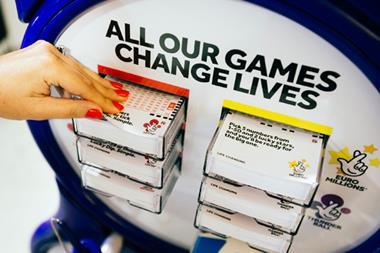In the early 1980s the percentage was more like 5% and McKinsey reckons firms are spending an extra 1% each year.
The pendulum is certainly swinging away from investment in the brand to investment in instore activities and in the multiple retailers. It may be an inevitable result of increased retail power and the multiples' desire to control costs through their supply chain, but it has also been driven by shoppers' reliance on deals and multibuys.
The practice has grown while TV advertising's grip on grocery spend has slipped, with more manufacturers using stores as the stage on which to promote their products. As a result, retailers have grown to depend on these trade funds as an important revenue stream.
The Code of Practice was designed to police any wrong doings by binding the biggest four multiples -- Tesco, Sainsbury, Asda and Safeway -- to "mutually beneficial agreements" with suppliers. But, apart from Express Dairies challenging the code last month, there has not been a word from manufacturers about whether the practice of trade funding is anything less than fair.
Investment through fear
Dave Telford, business development manager for consumer products at software firm SAP UK, believes the investment is not always made for the right reasons: "It is made because manufacturers have always done so and fear an adverse effect on their relationship with their customers if they don't."
Cadbury Trebor Bassett will not put a figure on it, but trade relations director Chris Morgan insists: "If it wasn't worth it and wasn't providing us with a profitable business, we'd review it."
There is no consensus on how big a part it really plays mainly because many manufacturers do not measure it accurately or use differing criteria, making it difficult to compare themselves with their peers.
There has already been one high profile example of the impact these extra costs can have. Last year the hole in drinks producer HP Bulmer's accounts swelled to £3.8m. The firm, which handles Strongbow and San Miguel, said unexpected promotional costs had been the cause, which forced it to cut back its plans for npd.
Trade funding, marketing or investment however you label it comprises discounts to net price, funding for consumer price reduction and a huge variety of payments such as display, listings and joint advertising, which makes it difficult to compare across customers, brands and territories.
Accenture's Mike Henderson, associate partner in the consumer goods practice, says it is a confusing picture because companies assess spend in different ways. "Each player has their own rationale there's no industry standard." But although they might play alone everyone is in it together. Harriet James, principal consultant at IBM business consulting services, adds: "It's a kind of game that no-one wants to be left out of. But there's a lot of disquiet."
That is an understatement. One big fmcg manufacturer says it is not unusual for a retailer to demand trade marketing spend in direct proportion to that retailer's market share. "They'll say you've got £100,000 for this new product we want x% of that'."
He says his firm is spending more each year. "Buying space, listings fees, buying other people's products out it's scandalous, but those are the rules of engagement the retailers are only doing their job."
Another, smaller manufacturer reveals: "We've been asked to pay a fee for dual siting this year, whereas we weren't last year.
"We now pay about 10% of revenue, although it's more with some stores you just have to negotiate hard. One retailer asked us for £25,000 but we managed to get them down to less than half that."
Protecting their brand equity is still key for manufacturers, some of whom question whether retailers always work in their best interest. Says Accenture's Henderson: "This is true particularly if they have a premium priced product. The style of a lot of cut price promotions would be seen as unravelling the brand equity work, although it may be helpful in driving short-term volume."
SAP's Telford agrees it can be hard for suppliers to get instore support for a promotion if it does not fit with the retailer's own strategy. He believes this makes it harder for manufacturers to control their relationship with shoppers and cites examples of categories such as sweet biscuits, where in the past, huge and dramatic investment in promotions such as bogofs has just led to brand switching.
"Trade promotions are a vital part of the relationship and there's an acceptance that many will not be profitable."
CTB's Morgan says generally the spend is worth it, particularly because of the nature of confectionery which means shoppers buy on promotion yet still make their regular purchases.
He says, although the company always post-evaluates promotions, it is hard to comprehensively measure the effects because of other factors, such as whether they have run in conjunction with TV advertising. "There so many reasons why people buy things you'll never get to the bottom of it."
Chance to regain control
Most consultants agree suppliers need to analyse their trade investment if they are to have any chance of regaining some control.
Telford reckons that although it is important to check money is being spent effectively, only 6% of manufacturers claim to have an effective process.
And IBM believes that firms need to get better transparency so they can compare their strategies across markets and agree a common trade fund framework. It also urges them to reorganise funding, taking it away from low priority business and reallocating it. That way it says, they can save as much as 10% of total budget.
Budgets also need to be shared more often so that field and key account members of the sales team, marketing, trade marketing, logistics, forecasting and finance all get to see promotion plans and budgets.
"There's a need to move from the salesman mindset to a business manager mindset the issue has gone from being a sales director issue to one for chief executive level," says Michael Reyner of McKinsey's UK consumer goods practice. He believes firms need an holistic programme, so they can develop the best customer management capabilities systems possible."Companies who go through a programme like this can see improvements of two percentage points of profit margin through a mixture of top and bottom line improvements."
A McKinsey study found top performers in the US consumer goods industry managed to raise their prices while increasing their market share, partly by sharing information on consumer spending habits with their salespeople. They also charged customers for extra services and managed their supply chains more efficiently.
But it is the way promotions are executed that is a real bugbear for manufacturers a problem IBM says is usually caused by lack of agreement and information between them and the retailer. It says manufacturers need to integrate their planning systems with supply chain systems so that they can forecast better and work more collaboratively.
But one manufacturer says: "It's an example of how we are being screwed. It's galling when we're giving them all this money and they're not implementing the basics they're still not stocking properly and either creating wastage by not rotating properly, or having out of stocks.
"Promotions may get a 10% uplift, but when we go on promotion the retailers maintain their margin while ours goes down by more than 50%. They're abusing their power in the market."
IBM says it can be particularly hard for smaller companies without big resources to find out how effective their promotions have been. But with this knowledge, suppliers can help retailers. Says James: "Retailers may be data rich but they still want support and analysis. They want competent business partners and this way manufacturers can score points."
She says retailers can be vulnerable too. In some cases they take the margin they get on a promotion and bank it for future activities, which can prove risky. Ahold's recent problems illustrate this vulnerability; it announced irregularities in "the recognition of income, including prepayment amounts related to US Foodservice's promotional allowance programmes".
But many manufacturers recognise that it's down to them to make the best decisions they can. Admits one: "Many of us don't analyse the process enough. We let ourselves off the hook and don't spend enough time working out why a promotion didn't work. At the end of the day, it's incumbent on us to say no to stop complaining and stand up for ourselves a bit more."
Another adds: "As a small manufacturer, we can't afford trade marketing and advertise above the line, but it doesn't matter because the most potent promotions are in store."
{{ANALYSIS }}
The pendulum is certainly swinging away from investment in the brand to investment in instore activities and in the multiple retailers. It may be an inevitable result of increased retail power and the multiples' desire to control costs through their supply chain, but it has also been driven by shoppers' reliance on deals and multibuys.
The practice has grown while TV advertising's grip on grocery spend has slipped, with more manufacturers using stores as the stage on which to promote their products. As a result, retailers have grown to depend on these trade funds as an important revenue stream.
The Code of Practice was designed to police any wrong doings by binding the biggest four multiples -- Tesco, Sainsbury, Asda and Safeway -- to "mutually beneficial agreements" with suppliers. But, apart from Express Dairies challenging the code last month, there has not been a word from manufacturers about whether the practice of trade funding is anything less than fair.
Investment through fear
Dave Telford, business development manager for consumer products at software firm SAP UK, believes the investment is not always made for the right reasons: "It is made because manufacturers have always done so and fear an adverse effect on their relationship with their customers if they don't."
Cadbury Trebor Bassett will not put a figure on it, but trade relations director Chris Morgan insists: "If it wasn't worth it and wasn't providing us with a profitable business, we'd review it."
There is no consensus on how big a part it really plays mainly because many manufacturers do not measure it accurately or use differing criteria, making it difficult to compare themselves with their peers.
There has already been one high profile example of the impact these extra costs can have. Last year the hole in drinks producer HP Bulmer's accounts swelled to £3.8m. The firm, which handles Strongbow and San Miguel, said unexpected promotional costs had been the cause, which forced it to cut back its plans for npd.
Trade funding, marketing or investment however you label it comprises discounts to net price, funding for consumer price reduction and a huge variety of payments such as display, listings and joint advertising, which makes it difficult to compare across customers, brands and territories.
Accenture's Mike Henderson, associate partner in the consumer goods practice, says it is a confusing picture because companies assess spend in different ways. "Each player has their own rationale there's no industry standard." But although they might play alone everyone is in it together. Harriet James, principal consultant at IBM business consulting services, adds: "It's a kind of game that no-one wants to be left out of. But there's a lot of disquiet."
That is an understatement. One big fmcg manufacturer says it is not unusual for a retailer to demand trade marketing spend in direct proportion to that retailer's market share. "They'll say you've got £100,000 for this new product we want x% of that'."
He says his firm is spending more each year. "Buying space, listings fees, buying other people's products out it's scandalous, but those are the rules of engagement the retailers are only doing their job."
Another, smaller manufacturer reveals: "We've been asked to pay a fee for dual siting this year, whereas we weren't last year.
"We now pay about 10% of revenue, although it's more with some stores you just have to negotiate hard. One retailer asked us for £25,000 but we managed to get them down to less than half that."
Protecting their brand equity is still key for manufacturers, some of whom question whether retailers always work in their best interest. Says Accenture's Henderson: "This is true particularly if they have a premium priced product. The style of a lot of cut price promotions would be seen as unravelling the brand equity work, although it may be helpful in driving short-term volume."
SAP's Telford agrees it can be hard for suppliers to get instore support for a promotion if it does not fit with the retailer's own strategy. He believes this makes it harder for manufacturers to control their relationship with shoppers and cites examples of categories such as sweet biscuits, where in the past, huge and dramatic investment in promotions such as bogofs has just led to brand switching.
"Trade promotions are a vital part of the relationship and there's an acceptance that many will not be profitable."
CTB's Morgan says generally the spend is worth it, particularly because of the nature of confectionery which means shoppers buy on promotion yet still make their regular purchases.
He says, although the company always post-evaluates promotions, it is hard to comprehensively measure the effects because of other factors, such as whether they have run in conjunction with TV advertising. "There so many reasons why people buy things you'll never get to the bottom of it."
Chance to regain control
Most consultants agree suppliers need to analyse their trade investment if they are to have any chance of regaining some control.
Telford reckons that although it is important to check money is being spent effectively, only 6% of manufacturers claim to have an effective process.
And IBM believes that firms need to get better transparency so they can compare their strategies across markets and agree a common trade fund framework. It also urges them to reorganise funding, taking it away from low priority business and reallocating it. That way it says, they can save as much as 10% of total budget.
Budgets also need to be shared more often so that field and key account members of the sales team, marketing, trade marketing, logistics, forecasting and finance all get to see promotion plans and budgets.
"There's a need to move from the salesman mindset to a business manager mindset the issue has gone from being a sales director issue to one for chief executive level," says Michael Reyner of McKinsey's UK consumer goods practice. He believes firms need an holistic programme, so they can develop the best customer management capabilities systems possible."Companies who go through a programme like this can see improvements of two percentage points of profit margin through a mixture of top and bottom line improvements."
A McKinsey study found top performers in the US consumer goods industry managed to raise their prices while increasing their market share, partly by sharing information on consumer spending habits with their salespeople. They also charged customers for extra services and managed their supply chains more efficiently.
But it is the way promotions are executed that is a real bugbear for manufacturers a problem IBM says is usually caused by lack of agreement and information between them and the retailer. It says manufacturers need to integrate their planning systems with supply chain systems so that they can forecast better and work more collaboratively.
But one manufacturer says: "It's an example of how we are being screwed. It's galling when we're giving them all this money and they're not implementing the basics they're still not stocking properly and either creating wastage by not rotating properly, or having out of stocks.
"Promotions may get a 10% uplift, but when we go on promotion the retailers maintain their margin while ours goes down by more than 50%. They're abusing their power in the market."
IBM says it can be particularly hard for smaller companies without big resources to find out how effective their promotions have been. But with this knowledge, suppliers can help retailers. Says James: "Retailers may be data rich but they still want support and analysis. They want competent business partners and this way manufacturers can score points."
She says retailers can be vulnerable too. In some cases they take the margin they get on a promotion and bank it for future activities, which can prove risky. Ahold's recent problems illustrate this vulnerability; it announced irregularities in "the recognition of income, including prepayment amounts related to US Foodservice's promotional allowance programmes".
But many manufacturers recognise that it's down to them to make the best decisions they can. Admits one: "Many of us don't analyse the process enough. We let ourselves off the hook and don't spend enough time working out why a promotion didn't work. At the end of the day, it's incumbent on us to say no to stop complaining and stand up for ourselves a bit more."
Another adds: "As a small manufacturer, we can't afford trade marketing and advertise above the line, but it doesn't matter because the most potent promotions are in store."
{{ANALYSIS }}
















No comments yet